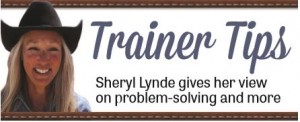 True horsemanship is a seamless marriage between timing and feel, and at the root of these skills is the ability to genuinely listen.
True horsemanship is a seamless marriage between timing and feel, and at the root of these skills is the ability to genuinely listen.
It can be discouraging when you attempt to have a conversation with someone who obviously is distracted or not engaged in the conversation. They may already be thinking of their reply while you are still talking, perhaps drawing from an experience in their past that presents either similar or contrasting to yours. Having a simple discussion can feel like a battle to be heard.
If you are feeling a lack of connection between you and your horse, you might help bridge the gap with an acute focus on listening to your horse’s responses to your cues. Every time I am riding and working on a specific issue, if I am not able to get the response I am looking for, the first thing I do is assess the manner in which I presented my cue.
For example, if I’m working a horse that braces on the bit and pulls the reins out of my hands, instead of getting into a tug-of-war between my hands and his mouth, I use my legs to soften him laterally. I know the more I work on his lateral flexion with my legs, the softer he will be vertically in my hands. If I pick up one rein, I will take the slack out until I feel resistance. At that point of resistance, I will use my leg and apply my calf to his rib cage. If he doesn’t soften and give to my hand, I will increase the pressure by rolling the rowel of my spur until he yields bringing his nose to his shoulder. When I feel him give, I release my leg. I will keep repeating until I can pick up one rein and he softens, bringing his face to his shoulder. If, instead of softening to my hand, he throws his head up in anticipation of my leg, I listen to his reaction and take inventory of how I applied my leg cue. Was my pressure too much and hurried? Did I go right to my spur instead of my calf? Next time I ask, I pay attention to smoothing out my request. I want to make sure I go in with my calf first and apply pressure, slowly but surely, until he yields. I want to build his confidence, not create fear with my legs or spurs. If he is exhibiting fear in his reaction, I need to pay attention to what he is telling me and correct how I ask him to perform a task. As Ray Hunt said, “my legs are as important as my arms and hands, if not more.” With an aid as important as my legs, I need to make sure I am using them properly for this horse, as each horse is different.
Now, conversely, if I apply my calf, then add my spur to no avail, I need to continue to add pressure until I get the response I am looking for. I can make the argument that I am using my legs; however, if I am not getting a response, then I need to add pressure. If my horse’s resistance is at a “level 6”, I need to continue to add pressure until I get to a “level 6.5” or “level 7” to get a response. If he isn’t upset or fearful, just a little dull in his response, then I need to be stronger with my leg. With consistent use of my leg cue using the accurate amount of pressure given each time, the dullness will be replaced with responsiveness. It takes listening to know the difference to what your horse is telling you.
I have a client who became a close friend. What a talker — she never stopped. It didn’t matter where I was, if I was in the vicinity, she was having a conversation with me. Whenever she rode her horse, she would have full blown conversations with him. “Hey, I didn’t ask you to trot, slow down, why are you drifting towards the other horses – Hey Sheryl… he isn’t listening to me .”
It appeared to me that she was the one who wasn’t listening. She needed to eliminate the conversation and feel what her horse was telling her that he was going to do. Her timing was off with her corrections, and she was always behind his actions because she wasn’t paying attention. You will be unable to develop timing and feel if you don’t quiet the endless stream of thoughts that intrude on a constant basis and learn to be present while in the saddle. You will be amazed at what you can learn by cultivating the art of listening.
Sheryl
Leave a Comment
All fields must be filled in to leave a message.